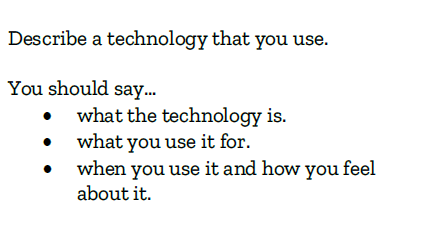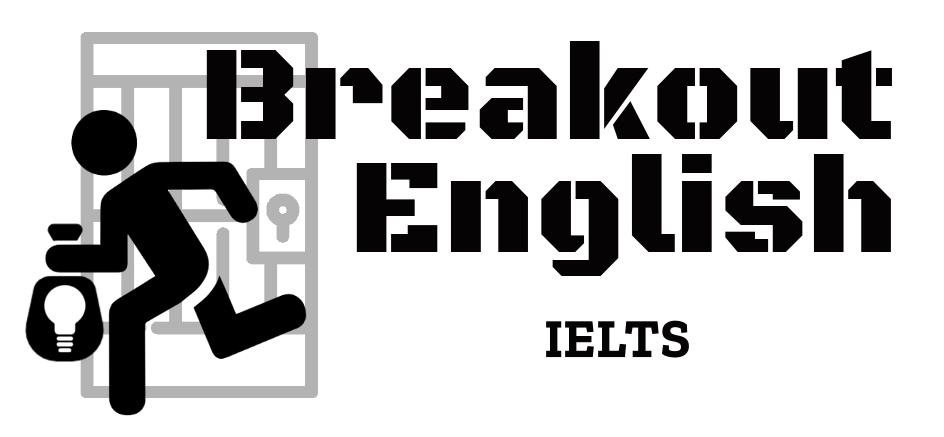IELTS Speaking Part 2 is a topic based task called the individual long turn. You receive a topic card with four different points to discuss. There are a wide range of topics, but some topics tend to be used a lot in IELTS Speaking. You get one minute to prepare your topic and two minutes to talk about it. The examiner will then ask a couple of extra questions about the same topic. This topic also continues into Speaking Part 3, where the questions will get a little bit more difficult and abstract.
Below, you’ll find some tips and tricks along with a set of topic cards to use individually or in your classroom.

Contents
IELTS Speaking Part 2 topics
IELTS Speaking Part 2 can include lots of different topics. Generally, the topic is something that is accessible for a range of language proficiency levels. For example, a topic about shopping can be talked about by someone who has a B1 level or a C2 level. It can also be expanded to include more abstract questions like high street vs online shopping or the issues with consumerism in society. That makes it a good option for an IELTS speaking topic. However, a topic about the global economy would not be a good option because it is accessible for higher level learners, but not lower levels.
Here is a list of possible topics for IELTS Speaking Part 2. There are more possible topics, but these are ones that come up often in practice exams.
- Your hobbies and interests
- Your town / city
- Work
- Learning (including learning languages)
- Technology, the internet and future innovations
- Sports and leisure activities
- Nature and the environment
- Food and healthy living
- Talents and creativity
- Family and friends
- Your childhood
- Travel and tourism
- Art and culture
- Shopping and fashion
- Daily life
- Entertainment (music, TV and film)
- Relationships and community
Here’s an example topic card talking about technology.

How to prepare to speak
You are allowed one minute to prepare for your topic. So after the examiner gives you the card, take full advantage of the time! The easiest and best thing to do is take some quick notes on a mini mind map. This doesn’t have to be exhaustive, and it won’t be with only one minute to prepare, but there are two main things you should do.
- Make a note of your answer for all four topic points.
- Make a note of any high level vocabulary that you can think of related to the topic.
Here’s an example of a mind map for the above topic.

Tips for IELTS Speaking Part 2
Part 2 in many ways is the “sink or swim” moment for a lot of IELTS candidates. It’s the only part of the exam where you are truly independent. The examiner isn’t going to ask you another question or interrupt you. In fact, this is the moment when they can judge you most because they can take a break from running the exam and really evaluate your level.
For that reason, it’s so important to practise plenty of different topics, speaking always for two minutes. It’s not a conversation. It’s not completely natural. But you can use that to your advantage by following these simple tips.
- Plan your answer – They give you a minute, so take advantage of it. You can plan a lot in a minute!
- Use your best vocabulary – If you want to get band 7 or higher, you need to use less common and idiomatic vocabulary. Time to remember those idioms, fixed expressions and phrasal verbs!
- Connect your ideas logically – Use linkers and structure your two minutes like a presentation with a clear beginning, middle and end. Use the four points of the topic to help you create a structure.
- Capture your audience – If you talk about something interesting, it’s far more likely to impress the examiner. I’d rather hear about your wild holiday in Thailand than Sunday lunch at your grandma’s house.
- Flex your grammar muscles – Even if it doesn’t always sound 100% natural, using some fancy advanced grammar like inversion, participle clauses or cleft sentences will get you extra points.
- Try not to repeat yourself – If you’ve run out of things to say, don’t repeat yourself. Instead, try talking about how you feel about the topic or tell a personal anecdote about yourself or someone you know.
- Enjoy it! – You may be a bundle of nerves, but if you try to keep it natural, like you are talking to a friend, it will sound so much better.
The materials
Use these topic cards in class or by yourself to practise IELTS Speaking Part 2. If you’re working alone, time yourself and record yourself with a voice recorder app on your phone. A day later, you can listen to the recording and self-evaluate.
EXAM PART: Speaking
EXAM SKILLS: Speaking at length and organising ideas coherently
TOPIC: Various
TIME: 45-60 minutes + extension
PREPARATION: One set of topic cards per pair of students
PROCEDURE:
- Introduce Speaking Part 2 by brainstorming different possible topics.
- Explain the format and timing or elicit from students.
- Choose a card and do a sample plan as a class on the board.
- Model speaking for two minutes and tell your students to say what you did well or badly. (It’s not as easy as you think! If you can’t do it, why should you expect your students to?)
- Split the group into pairs with one set of cards each.
- Students work through the cards, taking turns to speak.
- Encourage students to give feedback to their partners.
- Extension: have students think of two follow up questions for each topic card.
Download



